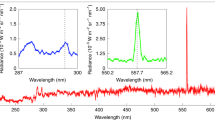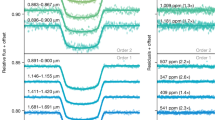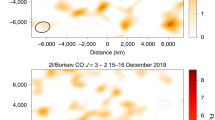Abstract
Having a nucleus darker than charcoal, comets are usually detected from Earth through the emissions from their coma. The coma is an envelope of gas that forms through the sublimation of ices from the nucleus as the comet gets closer to the Sun. In the far-ultraviolet portion of the spectrum, observations of comae have revealed the presence of atomic hydrogen and oxygen emissions. When observed over large spatial scales as seen from Earth, such emissions are dominated by resonance fluorescence pumped by solar radiation. Here, we analyse atomic emissions acquired close to the cometary nucleus by the Rosetta spacecraft and reveal their auroral nature. To identify their origin, we undertake a quantitative multi-instrument analysis of these emissions by combining coincident neutral gas, electron and far-ultraviolet observations. We establish that the atomic emissions detected from Rosetta around comet 67P/Churyumov-Gerasimenko at large heliocentric distances result from the dissociative excitation of cometary molecules by accelerated solar-wind electrons (and not by electrons produced from photo-ionization of cometary molecules). Like the discrete aurorae at Earth and Mars, this cometary aurora is driven by the interaction of the solar wind with the local environment. We also highlight how the oxygen line O i at wavelength 1,356 Å could be used as a tracer of solar-wind electron variability.
This is a preview of subscription content, access via your institution
Access options
Access Nature and 54 other Nature Portfolio journals
Get Nature+, our best-value online-access subscription
$29.99 / 30 days
cancel any time
Subscribe to this journal
Receive 12 digital issues and online access to articles
$119.00 per year
only $9.92 per issue
Buy this article
- Purchase on Springer Link
- Instant access to full article PDF
Prices may be subject to local taxes which are calculated during checkout




Similar content being viewed by others
Data availability
The Rosetta data that support the plots within this paper and other findings of this study are available from the ESA–PSA archive (https://www.cosmos.esa.int/web/psa/rosetta) or the NASA PDS archive (https://pdssbn.astro.umd.edu/data_sb/missions/rosetta/index.shtml) Source data are provided with this paper.
Code availability
iPIC3D is publicly available on GitHub (https://github.com/iPIC3D/iPIC3D; Apache License 2.0).
Change history
04 May 2021
A Correction to this paper has been published: https://doi.org/10.1038/s41550-021-01373-5
References
Taylor, M. G. G. T., Altobelli, N., Buratti, B. J. & Choukroun, M. The Rosetta mission orbiter science overview: the comet phase. Philos. Trans. R. Soc. A 375, 20160262 (2017).
Glassmeier, K.-H., Boehnhardt, H., Koschny, D., Kührt, E. & Richter, I. The Rosetta mission: flying towards the origin of the Solar System. Space Sci. Rev. 128, 1–21 (2007).
Stern, S. A. et al. Alice: the Rosetta ultraviolet imaging spectrograph. Space Sci. Rev. 128, 507–527 (2007).
Feldman, P. D. et al. Measurements of the near-nucleus coma of comet 67P/Churyumov-Gerasimenko with the Alice far-ultraviolet spectrograph on Rosetta. Astron. Astrophys. 583, A8 (2015).
Feldman, P. D. et al. The nature and frequency of the gas outbursts in comet 67P/Churyumov-Gerasimenko observed by the Alice far-ultraviolet spectrograph on Rosetta. Astrophys. J. Lett. 825, L8 (2016).
Feldman, P. D. et al. FUV spectral signatures of molecules and the evolution of the gaseous coma of comet 67P/Churyumov-Gerasimenko. Astron. J. 155, 9 (2018).
Chaufray, J.-Y. et al. Rosetta Alice/VIRTIS observations of the water vapour UV electroglow emissions around comet 67P/Churyumov-Gerasimenko. Mon. Not. R. Astron. Soc. 469, S416–S426 (2017).
Bieler, A. et al. Abundant molecular oxygen in the coma of comet 67P/Churyumov-Gerasimenko. Nature 526, 678–681 (2015).
Feldman, P. D. et al. HST/STIS ultraviolet imaging of polar aurora on Ganymede. Astrophys. J. 535, 1085–1090 (2000).
Molyneux, P. M. et al. Hubble space telescope observations of variations in Ganymede’s oxygen atmosphere and aurora. J. Geophys. Res. Space Phys. 123, 3777–3793 (2018).
Roth, L. et al. Transient water vapor at Europa’s south pole. Science 343, 171–174 (2014).
Lupu, R. E., Feldman, P. D., Weaver, H. A. & Tozzi, G.-P. The fourth positive system of carbon monoxide in the Hubble Space Telescope spectra of comets. Astrophys. J. 670, 1473–1484 (2007).
Sahnow, D. J., Feldman, P. D., McCandliss, S. R. & Martinez, M.-E. Long-slit ultraviolet spectroscopy of comet Austin (1990 v). Icarus 101, 71–83 (1993).
Galand, M. & Chakrabarti, S. in Atmospheres in the Solar System: Comparative Aeronomy (eds Mendillo, M. et al.) 55–76 (AGU, 2002).
Germany, G. A. et al. Remote determination of auroral energy characteristics during substorm activity. Geophys. Res. Lett. 24, 995–998 (1997).
Drossart, P. et al. Detection of H3+ on Jupiter. Nature 340, 539–541 (1989).
Bertaux, J.-L. et al. Discovery of an aurora on Mars. Nature 435, 790–794 (2005).
Hallinan, G. et al. Magnetospherically driven optical and radio aurorae at the end of the stellar main sequence. Nature 523, 568–571 (2015).
Lisse, C. M. et al. Discovery of X-ray and extreme ultraviolet emission from comet C/Hyakutake 1996 B2. Science 274, 205–209 (1996).
Hässig, M. et al. Time variability and heterogeneity in the coma of 67P/Churyumov-Gerasimenko. Science 347, aaa0276 (2015).
Migliorini, A. et al. Water and carbon dioxide distribution in the 67P/Churyumov-Gerasimenko coma from VIRTIS-M infrared observations. Astron. Astrophys. 589, A45 (2016).
Balsiger, H. et al. ROSINA Rosetta orbiter spectrometer for ion and neutral analysis. Space Sci. Rev. 128, 745–801 (2007).
Carr, C. et al. RPC: the Rosetta Plasma Consortium. Space Sci. Rev. 128, 629–647 (2007).
Keller, H. U. et al. Insolation, erosion, and morphology of comet 67P/Churyumov-Gerasimenko. Astron. Astrophys. 583, A34 (2015).
Coradini, A. et al. VIRTIS: an imaging spectrometer for the Rosetta mission. Space Sci. Rev. 128, 529–559 (2007).
Gulkis, S. et al. MIRO: microwave instrument for Rosetta orbiter. Space Sci. Rev. 128, 561–597 (2007).
Noonan, J. W. et al. Ultraviolet observations of coronal mass ejection impact on comet 67P/Churyumov-Gerasimenko by Rosetta Alice. Astron. J. 156, 16 (2018).
Witasse, O. et al. Interplanetary coronal mass ejection observed at STEREO-A, Mars, comet 67P/Churyumov-Gerasimenko, Saturn, and new horizons en route to Pluto: comparison of its Forbush decreases at 1.4, 3.1, and 9.9 AU. J. Geophys. Res. Space Phys. 122, 7865–7890 (2017).
Heritier, K. L. et al. Plasma source and loss at comet 67P during the Rosetta mission. Astron. Astrophys. 618, A77 (2018).
Galand, M. et al. Ionospheric plasma of comet 67P probed by Rosetta at 3 au from the Sun. Mon. Not. R. Astron. Soc. 462, S331–S351 (2016).
Strickland, D. J., Daniell Jr., R. E., Jasperse, J. R. & Basu, B. Transport-theoretic model for the electron-proton-hydrogen atom aurora. 2. Model results. J. Geophys. Res. Space Phys. 98, 21533–21548 (1993).
Fox, J. L. & Stewart, A. I. F. The Venus ultraviolet aurora—a soft electron source. J. Geophys. Res. 96, 9821–9828 (1991).
Deca, J. et al. Building a weakly outgassing comet from a generalized Ohm’s law. Phys. Rev. Lett. 123, 055101 (2019).
Divin, A. et al. A fully kinetic perspective of electron acceleration around a weakly outgassing comet. Astrophys. J. Lett. 889, L33 (2020).
Madanian, H. et al. Suprathermal electrons near the nucleus of comet 67P/Churyumov-Gerasimenko at 3 AU: model comparisons with Rosetta data. J. Geophys. Res. Space Phys. 121, 5815–5836 (2016).
Hull, A. J., Bonnell, J. W., Mozer, F. S., Scudder, J. D. & Chaston, C. C. Large parallel electric fields in the upward current region of the aurora: evidence for ambipolar effects. J. Geophys. Res. Space Phys. 108, 1265 (2003).
Lundin, R. et al. Plasma acceleration above Martian magnetic anomalies. Science 311, 980–983 (2006).
Schneider, N. M. et al. Discovery of diffuse aurora on Mars. Science 350, 0313 (2015).
Burch, J. L. et al. RPC-IES: the ion and electron sensor of the Rosetta Plasma Consortium. Space Sci. Rev. 128, 697–712 (2007).
Makarov, O. P. et al. Kinetic energy distributions and line profile measurements of dissociation products of water upon electron impact. J. Geophys. Res. Space Phys. 109, A09303 (2004).
Mumma, M. J., Stone, E. J., Borst, W. L. & Zipf, E. C. Dissociative excitation of vacuum ultraviolet emission features by electron impact on molecular gases. III. CO2. J. Chem. Phys. 57, 68–75 (1972).
Ajello, J. M. Emission cross sections of CO by electron impact in the interval 1260–5000 Å. I. J. Chem. Phys. 55, 3158–3168 (1971).
Kanik, I. et al. Electron impact dissociative excitation of O2. 2. Absolute emission cross sections of the OI(130.4 nm) and OI(135.6 nm) lines. J. Geophys. Res. Planets 108, 5126 (2003).
Heritier, K. L. Cometary Ionosphere Analysis from Rosetta Multi-instrument Dataset. PhD thesis, Imperial College London (2018); https://doi.org/10.25560/66101
Odelstad, E. et al. Measurements of the electrostatic potential of Rosetta at comet 67P. Mon. Not. R. Astron. Soc. 469, S568–S581 (2017).
Eriksson, A. I. et al. RPC-LAP: the Rosetta Langmuir probe instrument. Space Sci. Rev. 128, 729–744 (2007).
Edberg, N. J. T. et al. Solar wind interaction with comet 67P: impacts of corotating interaction regions. J. Geophys. Res. Space Phys. 121, 949–965 (2016).
Le Roy, L. et al. Inventory of the volatiles on comet 67P/Churyumov-Gerasimenko from Rosetta/ROSINA. Astron. Astrophys. 583, A1 (2015).
Gasc, S. et al. Sensitivity and fragmentation calibration of the time-of-flight mass spectrometer RTOF on board ESA’s Rosetta mission. Planet. Space Sci. 135, 64–73 (2017).
Jorda, L. et al. The global shape, density and rotation of Comet 67P/Churyumov-Gerasimenko from preperihelion Rosetta/OSIRIS observations. Icarus 277, 257–278 (2016).
Bockelée-Morvan, D. et al. First observations of H2O and CO2 vapor in comet 67P/Churyumov-Gerasimenko made by VIRTIS onboard Rosetta. Astron. Astrophys. 583, A6 (2015).
Dhiri, V. J. F., Vallat, C. & Kueppers, M. Rosetta: Payload Boresight Alignment Details (ESA, 2014); https://www.cosmos.esa.int/web/psa/rosetta
Fougere, N. et al. Direct simulation Monte Carlo modelling of the major species in the coma of comet 67P/Churyumov-Gerasimenko. Mon. Not. R. Astron. Soc. 462, S156–S169 (2016).
Biver, N. et al. Long-term monitoring of the outgassing and composition of comet 67P/Churyumov-Gerasimenko with the Rosetta/MIRO instrument. Astron. Astrophys. 630, A19 (2019).
Fink, U. et al. Investigation into the disparate origin of CO2 and H2O outgassing for comet 67/P. Icarus 277, 78–97 (2016).
Deca, J. et al. Electron and ion dynamics of the solar wind interaction with a weakly outgassing comet. Phys. Rev. Lett. 118, 205101 (2017).
Markidis, S., Lapenta, G. & Rizwan, U. Multi-scale simulations of plasma with iPIC3D. Math. Comput. Simulat. 80, 1509–1519 (2010).
Acknowledgements
Rosetta is a European Space Agency (ESA) mission with contributions from its member states and the National Aeronautics and Space Administration (NASA). We acknowledge the continuous support of the Rosetta teams at the European Space Operations Centre in Darmstadt and at the European Space Astronomy Centre. We acknowledge the staff of Centre de Données de la Physique des Plasmas (CDPP) and Imperial College for the use of Automated Multi-Dataset Analysis (AMDA) and the RPC Quicklook database. This work has benefited from discussions within International Team 402: Plasma Environment of Comet 67P after Rosetta at the International Space Science Institute (ISSI) (Bern, Switzerland). We thank N. Fougere for his help and advice using the ICES models. We are grateful to M. Taylor for his constructive feedback. Work at Imperial College London was supported by the STFC of the UK under grants ST/N000692/1 and ST/S505432/1, by Imperial College London through a President’s Scholarship, and by ESA under contract number 4000119035/16/ES/JD. The Alice team acknowledges support from NASA’s Jet Propulsion Laboratory through contract 1336850 to the Southwest Research Institute. M.R. acknowledges the support of the State of Bern and the Swiss National Science Foundation (200021_165869, 200020_182418). J.D. acknowledges support from NASA’s Rosetta Data Analysis Program, grant number 80NSSC19K1305, NASA’s Solar System Exploration Research Virtual Institute (SSERVI): Institute for Modeling Plasmas, Atmosphere, and Cosmic Dust (IMPACT), and the computational resources provided by the NASA High-End Computing (HEC) Program through the NASA Advanced Supercomputing (NAS) Division at Ames Research Center. We acknowledge PRACE for awarding us access to Curie at GENCI@CEA, France. Work at LPC2E/CNRS was supported by CNES and by ANR under the financial agreement ANR-15-CE31-0009-01. VIRTIS was built by a consortium, which includes Italy, France and Germany, under the scientific responsibility of the Istituto di Astrofisica e Planetologia Spaziali of INAF, Italy, which also guides the scientific operations. The VIRTIS instrument development, led by the prime contractor Leonardo-Finmeccanica (Florence, Italy), has been funded and managed by ASI, with contributions from Observatoire de Meudon financed by CNES, and from DLR. The VIRTIS calibrated data will be available through the ESA’s Planetary Science Archive (PSA) website (http://www.rssd.esa.int) and is available upon request until posted to the archive. We thank the following institutions and agencies for support of this work: Italian Space Agency (ASI, Italy) contract number I/024/12/1, Centre National d’Etudes Spatiales (CNES, France), DLR (Germany), NASA (USA) Rosetta Program, and Science and Technology Facilities Council (UK). All ROSINA data are the work of the international ROSINA team (scientists, engineers and technicians from Switzerland, France, Germany, Belgium and the USA) over the past 25 years, which we gratefully acknowledge. We acknowledge the contributions of the entire MIRO team in enabling collection of some of the data used in this study.
Author information
Authors and Affiliations
Contributions
M.G. led the study, performed the multi-instrument analysis, generated Figs. 2 and 3, and wrote the manuscript. P.D.F. identified times of interest for Alice, analysed the FUV dataset, advised on the different emission source mechanisms, and estimated the interplanetary medium contribution. D.B.-M. and Y.-C.C. analysed the VIRTIS-H dataset. N.B. analysed the MIRO dataset. G.R. analysed the VIRTIS-M dataset. M.R. and K.A. (the principal investigator of the ROSINA instrument) provided the ROSINA dataset. They all provided guidance on the interpretation of their respective dataset. J.D. generated Fig. 4 on the basis of the output of a particle-in-cell (PiC) simulation. J.D. and P.H. provided guidance on the PiC simulation interpretation. A.B., P.S. and K.L.H. provided feedback on the multi-instrument analysis. A.B. generated Fig. 1. J.Wm.P. (the principal investigator of the Alice instrument) contributed to the interpretation of the Alice dataset. C.C., A.I.E. and J.B. (all principal investigators of RPC) provided guidance on the interpretation of the RPC dataset. A.I.E. provided the RPC-LAP dataset. All authors contributed to the interpretation of the results and commented on this manuscript.
Corresponding author
Ethics declarations
Competing interests
The authors declare that they have no competing financial interests.
Additional information
Publisher’s note Springer Nature remains neutral with regard to jurisdictional claims in published maps and institutional affiliations.
Extended data
Extended Data Fig. 1 Differential electron flux as a function of energy.
Examples of differential electron fluxes measured by the RPC–IES electron spectrometer and used in the multi-instrument analysis. The fluxes were observed at 11:47 UT on 29 March 2015 (orange crosses) and at 08:35 UT on 26 December 2015 (red plus symbols) during two nadir-viewing FUV observation periods. The fluxes are corrected for the spacecraft potential (Galand et al.30; −2 V). By integration, the number density and mean energy of electrons with energies between 10 eV and 200 eV are derived and given in Extended Data Fig. 2.
Extended Data Fig. 2 Examples of Rosetta simultaneous measurements.
This dataset has been used for calculating the FUV atomic emission brightnesses at two times during FUV nadir-viewing observation periods (fourth and fifth cases in Figure 2): (1) the differential electron flux Je (see Extended Data Fig.1) measured by the RPC-IES electron spectrometer at the selected day and start time tIES (first and second columns), at a cometocentric distance rR (third column), and associated with a number density \({n}_{e}^{{\mathrm{IES}}}\) (fourth column) and mean energy \({E}_{e}^{{\mathrm{IES}}}\) (fifth column) of electrons with energies between 10 eV and 200 eV; (2) the total neutral density \({n}_{{\mathrm{tot}}}^{{\rm{COPS}}}\) measured by the ROSINA-COPS pressure gauge (sixth column) from which the column density CCOPS is derived (seventh column); (3) the neutral composition measured by the ROSINA-DFMS neutral mass spectrometer and given in terms of volume mixing ratio υn of the four major neutral species (eighth column). a The number density \({n}_{e}^{{\mathrm{IES}}}\) and mean energy \({E}_{e}^{{\mathrm{IES}}}\) of electrons with energies between 10 eV and 200 eV are derived by integrating the differential electron flux Je (corrected for the spacecraft potential) over the velocity space. These quantities are given for information; only Je, not its moments, is used in the calculation of the modelled FUV brightnesses. b The total column density is derived from the total neutral density ntot assuming a mean cometocentric distance for the nucleus' surface of 1.7 km50 (see Eq. 4). c The volume mixing ratio for the four major neutral species is obtained from the ROSINA/DFMS mass spectrometer (other species are neglected).
Source data
Source Data Fig. 2
Excel file: Observed and modelled brightnesses for the seven nadir-viewing cases presented for H Lyβ, O i 1,304 Å, and O i 1,356 Å (in Rayleigh).
Source Data Fig. 3
Excel file: Observed and modelled H Lyβ brightnesses for the two sets presented for limb viewing (in Rayleigh).
Source Data Fig. 4
ASCII file (VTK format): Includes glow (shown in violet), electron trajectory (lines colour-coded by energy) and ambipolar electric field (- Eambi green arrows).
Source Data Extended Data Fig. 1
Excel file: Two sets of differential electron fluxes as a function of energy, derived from RPC-IES after correction for the spacecraft potential.
Rights and permissions
About this article
Cite this article
Galand, M., Feldman, P.D., Bockelée-Morvan, D. et al. Far-ultraviolet aurora identified at comet 67P/Churyumov-Gerasimenko. Nat Astron 4, 1084–1091 (2020). https://doi.org/10.1038/s41550-020-1171-7
Received:
Accepted:
Published:
Issue Date:
DOI: https://doi.org/10.1038/s41550-020-1171-7
This article is cited by
-
The Comet Interceptor Mission
Space Science Reviews (2024)
-
The Plasma Environment of Comet 67P/Churyumov-Gerasimenko
Space Science Reviews (2022)



